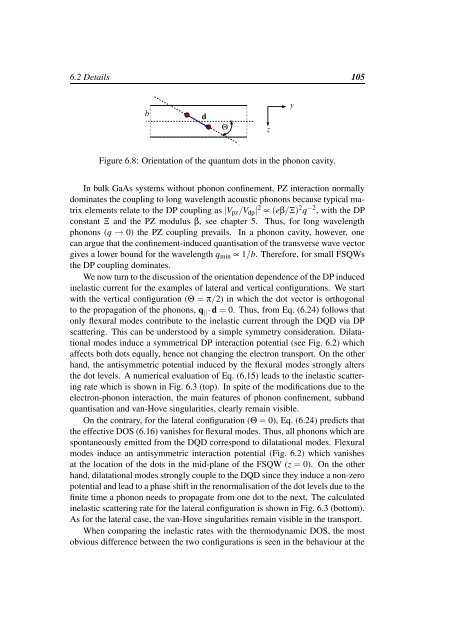Spin-orbit coupling and electron-phonon scattering - Fachbereich ...
Spin-orbit coupling and electron-phonon scattering - Fachbereich ...
Spin-orbit coupling and electron-phonon scattering - Fachbereich ...
You also want an ePaper? Increase the reach of your titles
YUMPU automatically turns print PDFs into web optimized ePapers that Google loves.
6.2 Details 105<br />
PSfrag replacements<br />
b<br />
d<br />
Θ<br />
z<br />
y<br />
Figure 6.8: Orientation of the quantum dots in the <strong>phonon</strong> cavity.<br />
In bulk GaAs systems without <strong>phonon</strong> confinement, PZ interaction normally<br />
dominates the <strong>coupling</strong> to long wavelength acoustic <strong>phonon</strong>s because typical matrix<br />
elements relate to the DP <strong>coupling</strong> as |V pz /V dp | 2 ∝ (eβ/Ξ) 2 q −2 , with the DP<br />
constant Ξ <strong>and</strong> the PZ modulus β, see chapter 5. Thus, for long wavelength<br />
<strong>phonon</strong>s (q → 0) the PZ <strong>coupling</strong> prevails. In a <strong>phonon</strong> cavity, however, one<br />
can argue that the confinement-induced quantisation of the transverse wave vector<br />
gives a lower bound for the wavelength q min ∝ 1/b. Therefore, for small FSQWs<br />
the DP <strong>coupling</strong> dominates.<br />
We now turn to the discussion of the orientation dependence of the DP induced<br />
inelastic current for the examples of lateral <strong>and</strong> vertical configurations. We start<br />
with the vertical configuration (Θ = π/2) in which the dot vector is orthogonal<br />
to the propagation of the <strong>phonon</strong>s, q ‖· d = 0. Thus, from Eq. (6.24) follows that<br />
only flexural modes contribute to the inelastic current through the DQD via DP<br />
<strong>scattering</strong>. This can be understood by a simple symmetry consideration. Dilatational<br />
modes induce a symmetrical DP interaction potential (see Fig. 6.2) which<br />
affects both dots equally, hence not changing the <strong>electron</strong> transport. On the other<br />
h<strong>and</strong>, the antisymmetric potential induced by the flexural modes strongly alters<br />
the dot levels. A numerical evaluation of Eq. (6.15) leads to the inelastic <strong>scattering</strong><br />
rate which is shown in Fig. 6.3 (top). In spite of the modifications due to the<br />
<strong>electron</strong>-<strong>phonon</strong> interaction, the main features of <strong>phonon</strong> confinement, subb<strong>and</strong><br />
quantisation <strong>and</strong> van-Hove singularities, clearly remain visible.<br />
On the contrary, for the lateral configuration (Θ = 0), Eq. (6.24) predicts that<br />
the effective DOS (6.16) vanishes for flexural modes. Thus, all <strong>phonon</strong>s which are<br />
spontaneously emitted from the DQD correspond to dilatational modes. Flexural<br />
modes induce an antisymmetric interaction potential (Fig. 6.2) which vanishes<br />
at the location of the dots in the mid-plane of the FSQW (z = 0). On the other<br />
h<strong>and</strong>, dilatational modes strongly couple to the DQD since they induce a non-zero<br />
potential <strong>and</strong> lead to a phase shift in the renormalisation of the dot levels due to the<br />
finite time a <strong>phonon</strong> needs to propagate from one dot to the next. The calculated<br />
inelastic <strong>scattering</strong> rate for the lateral configuration is shown in Fig. 6.3 (bottom).<br />
As for the lateral case, the van-Hove singularities remain visible in the transport.<br />
When comparing the inelastic rates with the thermodynamic DOS, the most<br />
obvious difference between the two configurations is seen in the behaviour at the
















